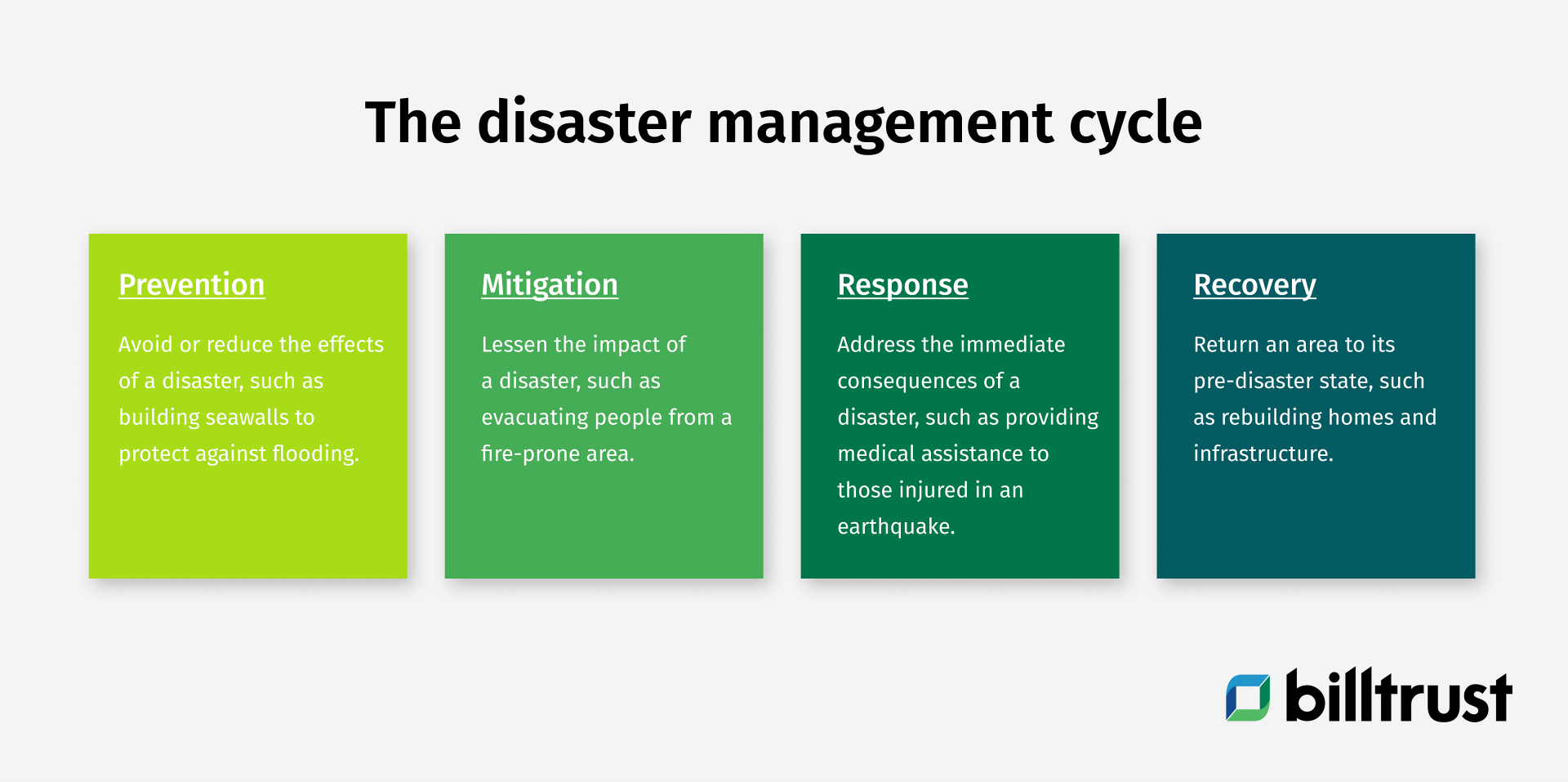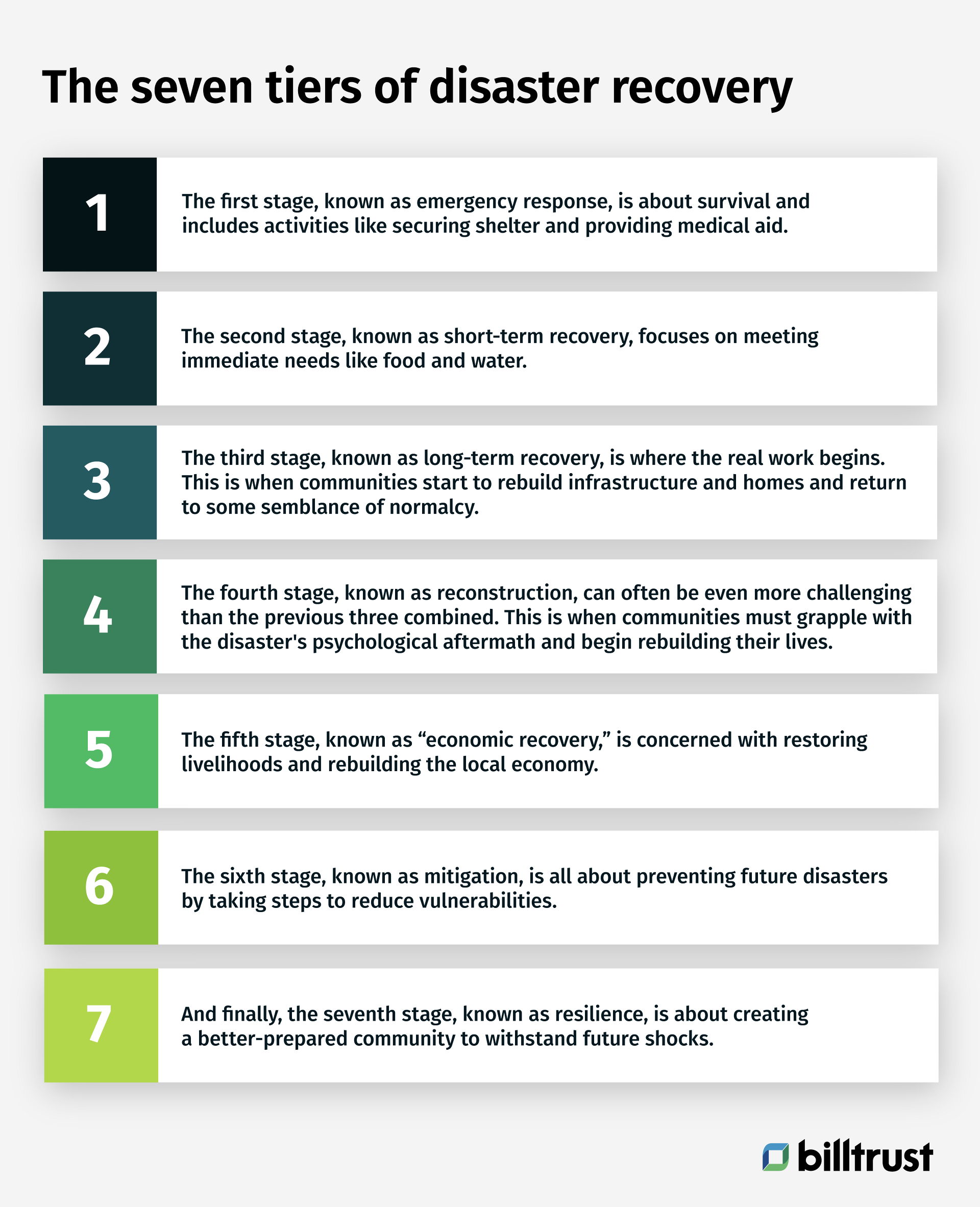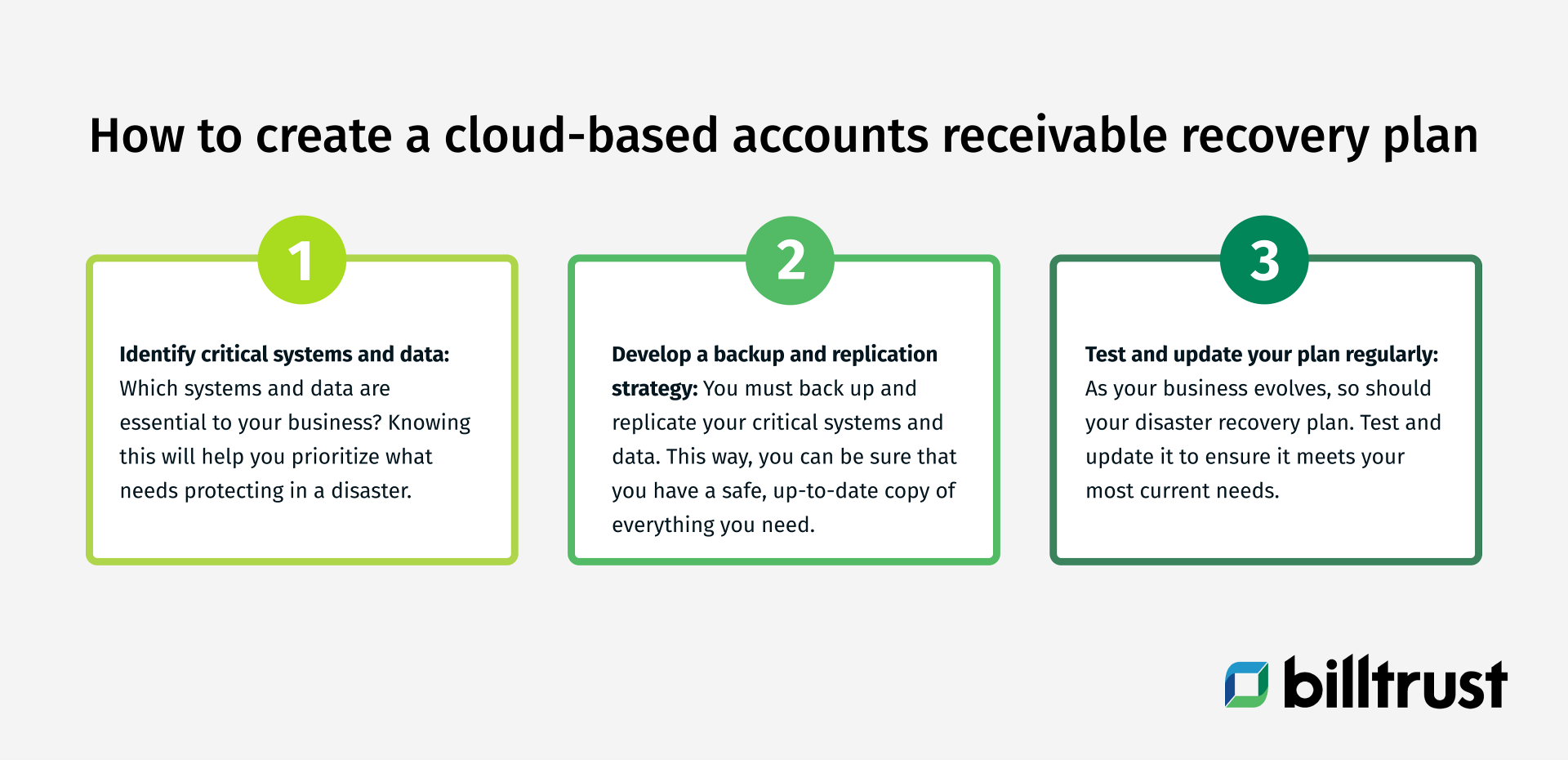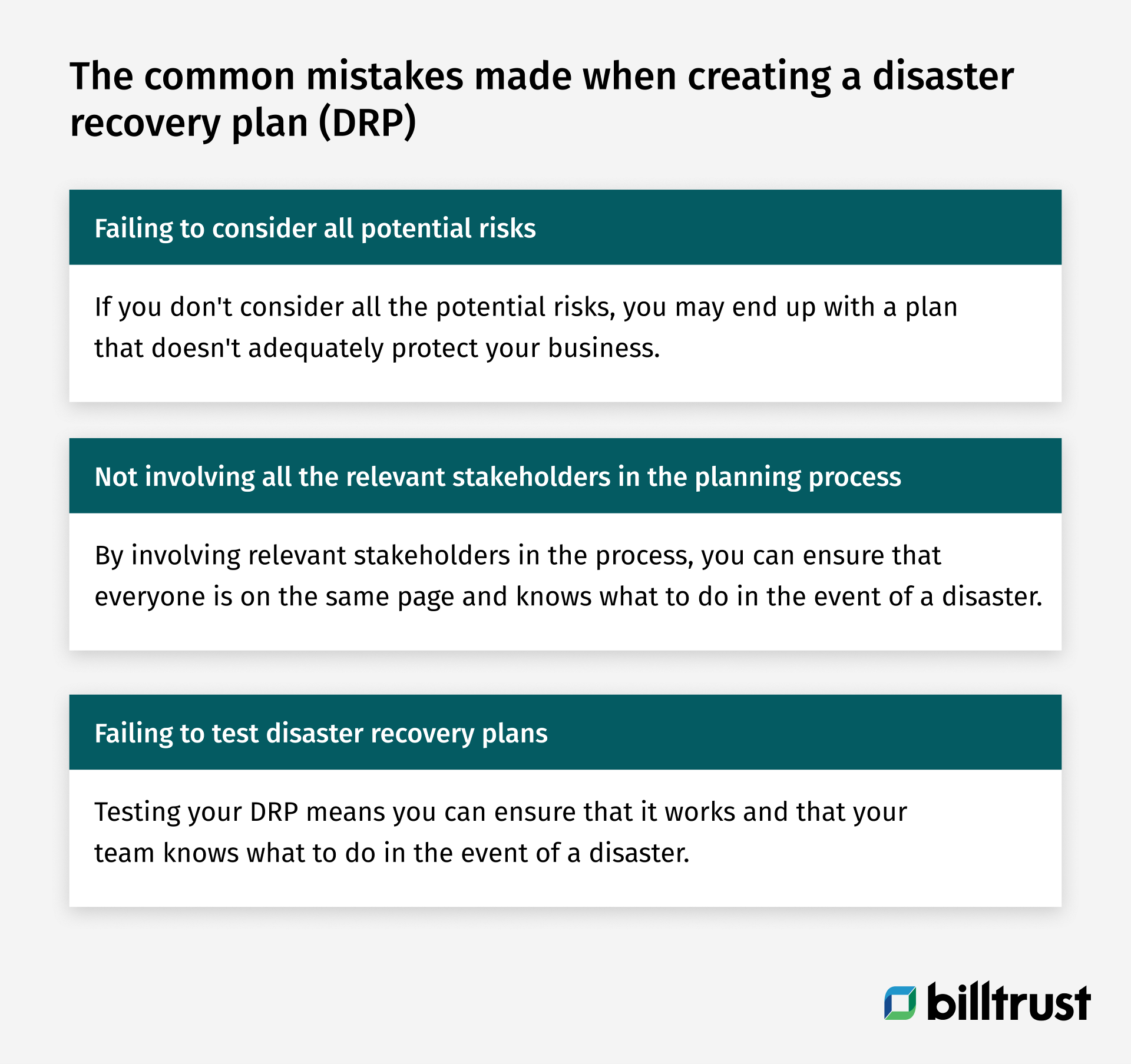There's no getting around it – accounts receivable is essential to any business. But what happens if something goes wrong and your receivables go south?
Disaster can strike at any time, so it's vital to have a plan in place to protect your business and its revenue. This blog post will discuss building an accounts receivable cloud disaster recovery plan.
What is a disaster management cycle?
Most people are familiar with the phrase "disaster management," but fewer know what it entails.
Disaster management is preparing for and responding to natural or manufactured disasters. It typically follows this four-stage cycle: prevention, mitigation, response and recovery:
- Prevention -Taken to avoid or reduce the effects of a disaster, such as building seawalls to protect against flooding.
- Mitigation - Used to lessen the impact of a disaster, such as evacuating people from a fire-prone area.
- Response - Addresses the immediate consequences of a disaster, such as providing medical assistance to those injured in an earthquake.
- Recovery - Returns an area to its pre-disaster state, such as rebuilding homes and infrastructure.
The bottom line?
A disaster management cycle is essential for protecting your business and your accounts receivable process.

Why is it essential to have an AR disaster recovery plan?
A cloud disaster recovery plan is a document that outlines how your business will recover from a disaster using the power of cloud technology.
It should include information on how to:
- Prevent or mitigate the effects of a disaster.
- Respond in the event of a disaster
- Recover after a disaster has occurred.
A well-executed cloud disaster recovery plan can help your business minimize a disaster's financial and operational impact.
No one likes to think about disasters, but the truth is that they can happen anytime, anywhere. And when they do, it's essential to be prepared.
A comprehensive accounts receivable cloud disaster recovery plan is so important. Such a plan can help a business quickly recover from many potential disasters, from fires and floods to data breaches and power outages.
Having a plan in place can minimize the financial impact of a disaster and ensure that you can resume operations quickly. In today's world, preparedness is vital, so ensure your business is ready for anything with a robust accounts receivable disaster recovery plan.
What are the seven tiers of disaster recovery?
As anyone who has ever survived a natural disaster knows, the road to recovery can be long and difficult. But what many people don't realize is that there are seven distinct stages of disaster recovery, each with its challenges and obstacles:
- First stage, emergency response - About survival and includes activities like securing shelter and providing medical aid.
- Second stage, short-term recovery - Focuses on meeting immediate needs like food and water.
- Third stage, long-term recovery - Where the real work begins. This is when communities start to rebuild infrastructure and homes and return to some semblance of normalcy.
- Fourth stage, reconstruction - Can often be even more challenging than the previous three combined. This is when communities must grapple with the disaster's psychological aftermath and begin rebuilding their lives.
- Fifth stage, “economic recovery" - Concerned with restoring livelihoods and rebuilding the local economy.
- Sixth stage, mitigation - All about preventing future disasters by taking steps to reduce vulnerabilities.
- Seventh stage, resilience - Creating a better-prepared community to withstand future shocks.
By understanding the seven stages of disaster recovery, we can be better prepared to meet the challenges.

What are some of the accounts receivable challenges in the disaster recovery process?
Accounts receivable can pose several challenges during the disaster recovery process:
- For one, tracking down customers who a disaster has displaced can be challenging. This can make it difficult to collect payments or even know who owes what.
- Additionally, disruptions to the supply chain can make it challenging to obtain the necessary materials to ship products or services.
- And finally, damaged infrastructure can make it difficult even physically to send invoices to customers.
These challenges can make accounts receivable a real headache during the disaster recovery process.
How can you overcome these challenges?
There are a few ways to overcome the challenges of accounts receivable in the disaster recovery process:
- First, it is essential to have a good customer relationship management (CRM) system in place. This will allow you to keep track of customers even if they are displaced.
- Additionally, it would help if you considered using electronic invoicing and payment methods to avoid disruptions to the supply chain.
These steps can make accounts receivable a much more accessible part of the disaster recovery process.
Why are cloud disaster recovery plans and AR automation important?
Disaster recovery is a term that gets thrown around a lot, but what does it mean?
In short, disaster recovery (or DR) is a plan to deal with a catastrophic event. This can include anything from a natural disaster to a malicious hacking attack.
No matter the cause, a disaster can have severe consequences for businesses, including downtime, data loss, and reputational damage. That's why it's so important to have a solid DR strategy in place.
One of the most effective ways to do this is through cloud-based disaster recovery (Cloud DR) and AR automation.
Cloud DR provides an off-site backup of data and applications, making it possible to restore systems after an outage quickly.
It also offers greater flexibility and scalability than traditional DR solutions, making it well-suited for today's dynamic business environment. In addition, automated AR ensures you maintain your cash flow without a hitch.
In summary, cloud disaster recovery plans and AR automation are well worth considering if you want to ensure your business can withstand anything from the world.
No matter the cause, a disaster can have severe consequences for businesses, including downtime, data loss, and reputational damage. That's why it's so important to have a solid DR strategy in place.
What is the difference between a DRP and a BCP?
When it comes to disaster preparedness, businesses have two main options: a disaster recovery plan (DRP) or a business continuity plan (BCP). Both offer advantages in preventing downtime and protecting data, but differ in their focus and approach.
A DRP primarily concerns getting systems up and running after a disaster.
At the same time, a BCP takes a broader view, focusing on maintaining essential operations despite adversity.
As a result, leadership may see a business continuity plan (BCP) as the more comprehensive option, but a DRP can be less expensive and easier to implement. Ultimately, the best approach for any business will depend on its specific needs and resources.
Both are critical tools, but they have distinct purposes.
For example, a disaster recovery plan (DRP) focuses on restoring vital functions, while a BCP focuses on maintaining operations during and after a disaster.
In other words, a DRP is about getting things back to normal, while a BCP is more comprehensive since it’s about keeping things running smoothly.
DRP and BCP plans are essential and you should consider having both in place.
How do you create a cloud-based AR disaster recovery plan?
If you live in an area prone to natural disasters, it's essential to have a cloud disaster recovery plan in place to protect your business. But unfortunately, many people don't know where to start. There are many factors to consider when crafting a disaster recovery plan, but here are a few of the most important:

- Identify critical systems and data: The first step is identifying which systems and data are essential to your business. This will help you prioritize what needs protecting in a disaster.
- Develop a backup and replication strategy: Once you've identified your critical systems and data, you need to develop a plan for backing them up and replicating them. This way, you can be sure that you have a safe, up-to-date copy of everything you need.
- Test and update your plan regularly: Testing helps you identify weaknesses to make necessary changes—for example, your cybersecurity. Also, update your plan as your business evolves so that it always reflects your most current needs.
What are some common mistakes people make when creating a DRP?
Creating a DRP can be a daunting task. There are so many things to consider, and it's easy to make a mistake. Here are some of the most common mistakes people make when creating a DRP:
Failing to consider all potential risks
It's essential to consider all the different types of disasters that could occur in your area, from natural disasters like floods and earthquakes to disasters like fires and power outages.
By failing to consider all the potential risks, you could end up with a plan that doesn't adequately protect your business.
Not involving all the relevant stakeholders in the planning process
It's essential to include relevant stakeholders who may be affected by a disaster, from employees and customers to suppliers and partners. By involving everyone in the process, you can ensure your team is on the same page and knows what to do in the event of a disaster.
Failing to test disaster recovery plans
Creating a plan is not enough; you must ensure it works. The best way to do this is to run regular drills and simulations. This will help you identify any weaknesses in your plan and ensure everyone knows what to do in a disaster.

The key is to prepare for anything.
By avoiding these common mistakes, you can create a disaster recovery plan that will help keep your business safe in the event of a disaster.
And best of all, by creating a disaster recovery plan, you can give yourself peace of mind knowing that you and your business will be safe in the event of a disaster.
Create an accounts receivable disaster recovery plan today
It's no secret that cloud storage and automation have changed the disaster recovery game.
In the past, companies would invest heavily in on-premises infrastructure, including redundant power supplies and backup generators. But now, with cloud-based automation solutions, businesses can take advantage of a pay-as-you-go model that scales up or down as needed.
The cloud offers built-in redundancy and high availability, so businesses can be confident that their data is always safe and accessible. But, while the cloud has made disaster recovery more accessible than ever before, there are still some challenges to consider:
For example, it's crucial to understand your organization's specific needs clearly. So you may consider what data you need to back up, how often you need to access it and how much you are willing to spend.
Once you understand your needs, you can start researching different cloud-based disaster recovery solutions.
There are many effective options, so take your time and find the right one for your business. Then, with some planning and preparation, you can build an effective, automated disaster recovery plan for the cloud era.
Download the ultimate guide to digital accounts receivable

Get top tips and fresh insights that will help you control your cash flow and your daily calendar of AR tasks.

